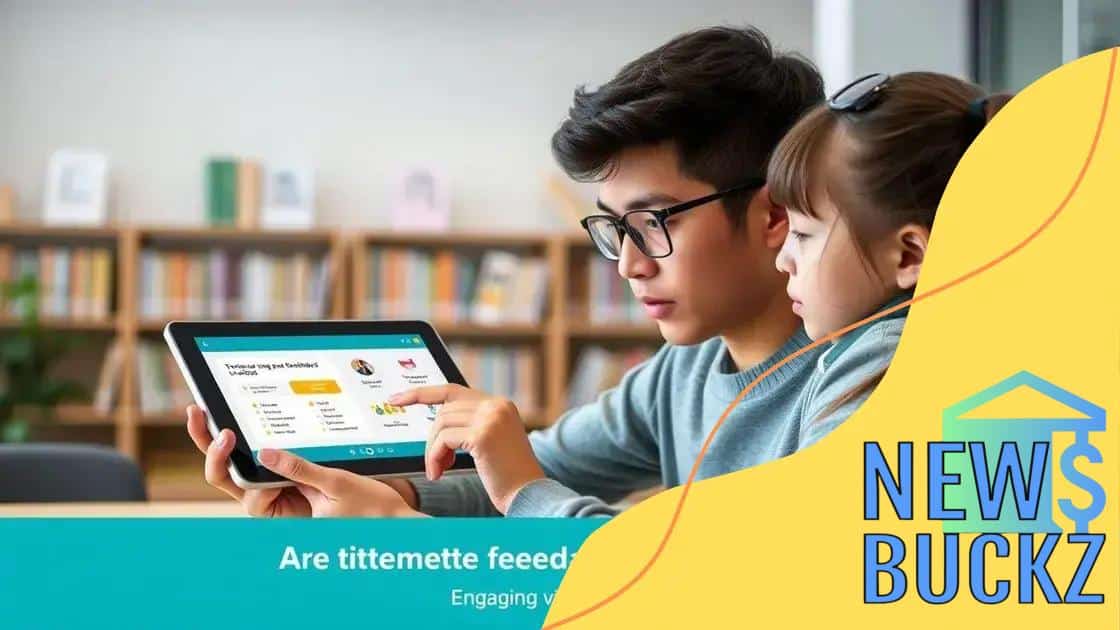How AI is improving language learning experiences

Anúncios
AI is improving language learning experiences by providing personalized, interactive tools, real-time feedback, and adaptive content that cater to diverse learners, enhancing engagement and effectiveness.
How AI is improving language learning experiences is a topic that’s capturing everyone’s attention. Imagine having a personal tutor available 24/7, adjusting to your unique learning style. Fascinating, right?
Anúncios
Personalized learning experiences with AI
Personalized learning experiences with AI transform how language learners engage with new material. By using data, AI can tailor lessons to fit individual needs, making the learning process more efficient and enjoyable. Imagine having study materials designed just for you!
Customizing Learning Paths
With AI, teachers can create custom learning paths that adapt based on a student’s progress. This personalized approach allows learners to focus on areas where they need improvement.
- Adaptive exercises that challenge learners appropriately.
- Lessons that cater to individual learning speeds.
- Feedback tailored to specific errors for better understanding.
The ability of AI to analyze large amounts of data lets it offer real-time insights. These insights help both learners and educators identify what works and what doesn’t. Furthermore, this feedback loop fosters an environment where students feel more confident in their abilities, encouraging autonomy in their studies.
Anúncios
Enhanced Engagement
When learning is customized, it becomes more engaging. AI uses gamification to make lessons fun, turning language learning into an interactive experience.
- Interactive quizzes that adapt based on results.
- Games that reinforce vocabulary in a playful manner.
- Community features allowing learners to practice with peers.
With features like virtual reality and speech recognition, AI creates immersive experiences. These tools allow students to converse in real-life scenarios, building practical skills while having fun.
As technology progresses, the role of AI in education continues to grow. Personalized learning experiences will only get better, paving the way for unique educational journeys.
Interactive tools making language learning fun
Interactive tools are revolutionizing how we learn languages, making the process not only effective but also fun. These tools capture students’ attention and enhance their learning experiences. By integrating gamification and engaging content, language learning becomes a delightful adventure.
Gamified Learning Experiences
One of the key benefits of interactive tools is gamification. These tools turn learning into a game, where students can earn points and rewards.
- Quizzes that add competition among peers.
- Levels that learners can achieve as they progress.
- Badges for accomplishing milestones, promoting motivation.
Gamification helps students stay engaged and motivated. This approach transforms routine language exercises into enjoyable challenges, making practice feel less like work and more like fun.
Engagement Through Multimedia
Interactive tools incorporate exciting multimedia elements such as videos, animations, and audio. These resources not only make learning dynamic but also cater to different learning styles.
- Videos that illustrate language usage in real-life contexts.
- Audio clips that help with pronunciation and listening skills.
- Interactive activities like matching words with pictures to reinforce vocabulary.
These creative components help solidify understanding and keep students engaged. As they explore new words and grammar rules through various media, learners are more likely to retain information.
Furthermore, social features allow students to connect with others. This enables them to practice their skills in real conversation settings, building confidence while learning. Engaging with peers creates a supportive environment where learners feel inspired to improve.
Overall, interactive tools create an immersive language learning experience that combines education with enjoyment. By blending play with study, these tools successfully promote effective learning strategies and foster a love for languages.
Real-time feedback and assessment

Real-time feedback and assessment are changing the way students learn languages. Instead of waiting for a teacher to review exercises, learners can get immediate responses. This instant feedback helps students understand their mistakes and correct them on the spot.
Immediate Corrections
With advanced AI technology, language apps can offer immediate corrections while users practice. This allows for a quicker learning curve as students can see where they went wrong right away.
- Instant alerts on grammar and pronunciation errors.
- Suggestions for improvement based on user performance.
- Tracking progress over time to celebrate growth.
This kind of support encourages learners to experiment and take risks with language. Knowing that mistakes are part of the process allows them to feel more confident and motivated.
Personalized Learning Plans
AI-driven systems can assess how well a student understands core concepts. From this, they can create personalized learning plans that adapt as the learner progresses.
- Dynamic adjustments to difficulty based on user performance.
- Recommendations for specific exercises to target weaknesses.
- Progress reports that help learners stay informed of their growth.
This level of customization helps each student feel more engaged and responsible for their learning journey. Engagement grows as learners see their improvements, making the overall learning experience more rewarding.
Moreover, teachers benefit from these assessments as well. They can use data collected by AI tools to identify trends in student performance. This information enables educators to tailor their instruction to meet individual needs more effectively, supporting a more comprehensive educational approach.
With real-time feedback and assessment, language learning becomes more interactive and focused. This means that every learner, regardless of their initial level, can pursue their language goals with confidence and clarity.
AI-driven content for diverse learners
AI-driven content is essential for meeting the needs of diverse learners. This technology recognizes that every student has different learning styles and preferences. By providing tailored educational material, it enhances the overall learning experience.
Adaptive Learning Materials
Adaptive learning platforms use AI to analyze a student’s progress and modify content accordingly. This ensures that each learner receives material suited to their skill level.
- Difficulty levels adjust based on quiz performance.
- Content recommendations improve engagement and understanding.
- Feedback provided helps reinforce lessons effectively.
Such personalized approaches motivate students to learn at their own pace, ensuring they grasp essential concepts before advancing.
Support for Different Learning Styles
AI can create various formats for learning materials, catering to visual, auditory, and kinesthetic learners. This versatility helps ensure that students can access information in their preferred style.
- Videos and animations for visual learners.
- Audio recordings and podcasts for auditory learners.
- Interactive exercises for kinesthetic learners.
When learners interact with content that resonates with their preferred learning style, they are more likely to retain information. This approach promotes deeper understanding and encourages exploration of topics.
Moreover, AI technology is capable of analyzing diverse cultural backgrounds, integrating relevant examples into lessons. This connection helps students see the practical applications of what they learn in a wider context, enhancing motivation.
With AI-driven content, education becomes more inclusive and responsive. As a result, students from various backgrounds can engage fully and benefit from tailored educational experiences that foster their unique potentials.
Future trends in AI language learning
Future trends in AI language learning promise exciting changes in how we acquire new languages. As technology continues to advance, we can expect even more innovative tools that enhance the learning experience. AI will increasingly play a vital role in making language education more effective and enjoyable.
Enhanced Personalization
One of the biggest trends is the move toward even greater personalization of learning materials. Future AI tools will analyze individual learners more deeply, including their preferences, strengths, and weaknesses.
- Tailored learning paths that adjust as students progress.
- Content delivered in a format best suited to each learner.
- Integrated assessments to measure growth in real-time.
This personalization will help students feel more in control of their learning, allowing them to move at their own pace and focus on areas needing improvement.
Integration of Virtual and Augmented Reality
Future AI language learning platforms are expected to incorporate more virtual and augmented reality experiences. This technology will immerse learners in realistic environments, making it easier to practice conversational skills.
- Simulated scenarios for real-world language use.
- Interactive language games within immersive settings.
- Collaboration with others in virtual classrooms for practicing skills.
Such experiences can enhance engagement and retention, allowing learners to practice conversational skills in safe, controlled environments.
We can also expect AI to facilitate more opportunities for authentic language practice. Future applications might connect learners with native speakers through interactive platforms, allowing for real conversations that build confidence and fluency.
Additionally, the integration of AI in educational institutions will promote a shift toward collaborative learning. Students may engage in language projects using AI tools that foster teamwork and peer interaction, enhancing the whole learning process.
With these emerging trends, the future of AI in language learning looks promising. By embracing innovative technologies, we can create more enriched and effective language learning environments for everyone.
In summary, AI is transforming language learning in remarkable ways. From personalized content that fits individual learning styles to interactive tools that make studying enjoyable, the advancements in technology are paving the way for a better educational experience. As we look to the future, we can expect even more exciting innovations that will help diverse learners effectively acquire new languages. By embracing these changes, students will gain the confidence they need to succeed in their language journeys.
FAQ – Frequently Asked Questions about AI in Language Learning
How does AI personalize language learning?
AI personalizes language learning by analyzing individual progress and tailoring content to match students’ learning styles and paces.
What types of interactive tools are used in language learning?
Language learning uses tools like gamified exercises, quizzes, and multimedia content to engage students and make learning enjoyable.
What is real-time feedback in AI language learning?
Real-time feedback allows students to receive immediate corrections and suggestions while practicing, helping them learn effectively.
How will AI shape the future of language education?
The future of language education will include more personalized experiences, immersive environments, and opportunities for authentic language practice through AI.





